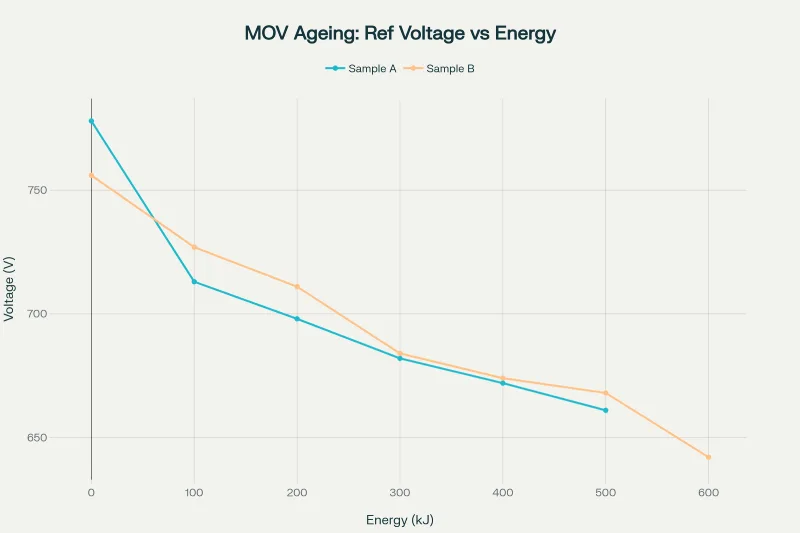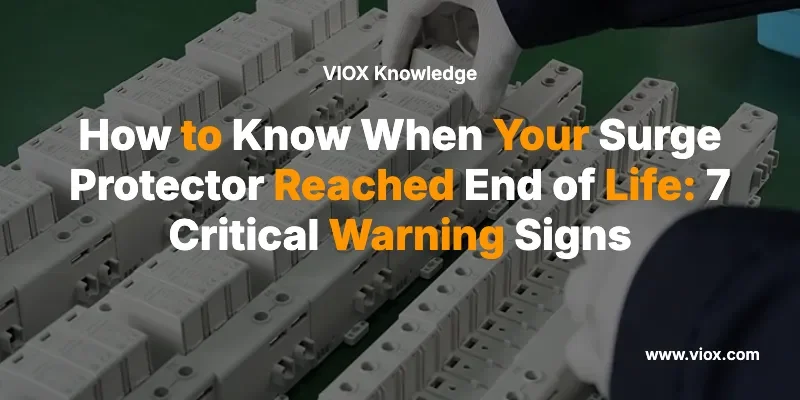s
A rejtett veszély: Miért fontos a túlfeszültség-védő élettartamának vége?
Túlfeszültség-védők Használjon fém-oxid varisztoroknak (MOV) nevezett alkatrészeket, amelyek elnyelik a túlfeszültséget a túlfeszültségek során. Ezek az alkatrészek minden egyes elnyelt túlfeszültséggel fokozatosan lebomlanak, végül teljesen elveszítik védőképességüket. Amikor ez megtörténik, a túlfeszültség-védő továbbra is működhet áramforrásként, de semmilyen védelmet nem nyújt az elektromos károk ellen.

Az ijesztő rész? Gyakorlatilag lehetetlen pontosan megmondani, hogy mikor nem működik megfelelően egy túlfeszültség-védő, ezért a figyelmeztető jelek felismerése kulcsfontosságú a befektetés védelme érdekében.
7 kritikus jel, hogy a túlfeszültség-védője elérte az élettartama végét
1. Jelzőfény problémák: Az elsődleges figyelmeztető rendszer
Sok túlfeszültségvédő LED diagnosztikai jelzőfényekkel rendelkezik, amelyek folyamatosan világítanak, amikor az eszköz működőképes és védelmet nyújt. A nem világító diagnosztikai jelzőfény azt jelzi, hogy az eszközt ki kell cserélni.
Mit kell keresni:
- Zöld lámpa kialszik: A védelem sikertelen
- Piros lámpa világít: Gyakran inkább sérülést vagy élettartam végét jelzi, mint aktív védelmet
- Egyáltalán nincs lámpa: Teljes rendszerhiba
Fontos megjegyzés: Nem feltétlenül lehet ezekre a lámpákra hagyatkozni, mivel nem egy bolondbiztos rendszer, de értékes korai figyelmeztető jeleket adnak.
2. Látható fizikai sérülés
A kopás és elhasználódás legnyilvánvalóbb jele a túlfeszültség-védő látható sérülése, beleértve az égés jeleit, az olvadt műanyagot, a foszladozó vezetékeket vagy az elszíneződést.
A vészjelzők a következők:
- Pörkölésnyomok vagy elszíneződés a csatlakozóaljzatok körül
- Repedt vagy megolvadt műanyag ház
- Rojtosodott vagy sérült tápkábelek
- Égési nyomok a készülék külsején
- Bármilyen túlmelegedési károsodás jele
Szükséges intézkedés: Azonnal cserélje ki, ha bármilyen fizikai sérülés látható.
3. Túlmelegedési problémák
A túlfeszültség-védők általában nem termelnek sok hőt. Ha azt veszi észre, hogy a készülék szokatlanul forró tapintásra, az belső sérülés vagy meghibásodás jele lehet.
Hőmérséklet-riasztó jelek:
- A készülék normál működés közben melegnek vagy forrónak érződik
- A műanyag ház puhává vagy hajlékonysá válik
- Szokatlan hő árad a konnektorokból
- A készülék minimális terhelés mellett is felforrósodik
4. Korfüggő pótlási ütemterv
A 3-5 éves szabály: A túlfeszültség-védők jellemzően 3-5 évig tartanak normál használat mellett, a használattól és a túlfeszültségnek való kitettségtől függően.
Azonnal cserélje ki, ha:
- A túlfeszültség-védője több mint 5 éves
- Több áramkimaradást vagy vihart tapasztaltál
- Egy olyan területen élsz, ahol instabil az elektromos hálózat
- A viharoknak kitett területeken, mint például Floridában, minden két évnél régebbi túlfeszültség-védő valószínűleg elavulttá vált.
| Környezetvédelem | Tipikus élet | Indoklás |
|---|---|---|
| Otthon/irodában kevés vihar | 5 év | A fényhullámok száma lassan romlik a MOV értéken |
| Zivatarokra hajlamos régiók | 3 év | A gyakori tranziensek hamarabb kimerítik a joule-keretet |
| Nagy hibaáramú ipari panelek | 1-2 év | A magasabb MCOV és a túlfeszültség-áramok felgyorsítják az öregedést |
Mindig azonnal cserélje ki villámcsapás után, vagy ha az állapotjelző lámpa kialszik.
5. Eszközteljesítmény-problémák
Alacsony feszültségű túlfeszültség-védők esetében a meghibásodás akkor válik nyilvánvalóvá, amikor a csatlakoztatott berendezés nem működik megfelelően, mivel az adatok vagy jelek nem tudnak áthaladni a sérült áramkörön.
Teljesítménymutatók:
- A csatlakoztatott eszközök időszakos áramellátási problémákat tapasztalnak
- A berendezés váratlanul leáll
- Adatátviteli problémák a csatlakoztatott eszközökben
- Az eszközök nem kapnak egyenletes áramellátást
6. Legutóbbi jelentős áramkimaradások
Ha tudod, hogy a túlfeszültség-védőd komoly túlfeszültséget nyelt el, valószínűleg azonnal ki kell cserélned.
Csere a következő események után:
- Villámcsapások a közvetlen környezetedben
- Súlyos áramkimaradások vagy hálózatváltási események
- Látható elektromos túlfeszültségek, amelyek hatással vannak otthonára
- Bármely olyan esemény, amely más elektronikai berendezések meghibásodását okozta
7. Hangjelző rendszerek
A fejlett túlfeszültség-védők néha proaktív élettartam-kimaradás-jelzést kínálnak hangjelzések formájában. Amikor riasztás hallható ezen fejlett túlfeszültség-védők egyikén, azonnal tudni fogja, hogy a túlfeszültség-védő sérült, és ki kell cserélni.
Figyelj a következőkre:
- Sípoló vagy zümmögő hangok
- Szaggatott riasztási jelek
- Bármilyen szokatlan zaj hallható a készülékből
A túlfeszültség-védő élettartamának megértése: Nem az évekről szól
Íme egy kulcsfontosságú fogalom, amit sokan félreértenek: a túlfeszültség-védők élettartamát nem években mérik, hanem joule-ban. Arról van szó, hogy a túlfeszültség-védő hány joule-t nyelt el.
A Joule-besorolási rendszer
Minden egyes túlfeszültség, amit a túlfeszültség-védő elnyel, csökkenti a jövőbeni joule-ok mennyiségét, amelyet el tud viselni. Ha egy 1000 joule-os túlfeszültség-védő 1000 joule-os ütést kap, akkor vége. De az is vége, ha tíz 100 joule-os ütést kap – vagy ha ezeregy joule-os ütést. Mindez kumulatív.
Joule-besorolási irányelvek:
- 1000+ joule: Jobb a nagy értékű elektronikához
- 500-1000 joule: A legtöbb otthoni használatra megfelelő
- 500 joule alatt: Csak alap védelem
Az élettartamot befolyásoló környezeti tényezők
A környezeti feltételek, mint például a hő, a páratartalom és a por, befolyásolhatják a túlfeszültség-védők teljesítményét. A tiszta, hűvös és száraz környezetben tartásuk segíthet meghosszabbítani az élettartamukat.
Élettartamcsökkentők:
- Magas páratartalmú környezetek
- Túlzott hőhatás
- Poros vagy szennyezett körülmények
- Túlterhelés jelentős energiát fogyasztó eszközökkel
- Gyakori áramingadozások a környéken
Mikor kell azonnal cserélni a túlfeszültség-védőt?
Ne várj ezekre a helyzetekre:
- Bármilyen nagyobb vihar vagy áramkimaradás után
- Amikor a jelzőfények meghibásodnak vagy megváltoznak
- Ha a készülék bármilyen fizikai sérülést mutat
- Miután elérte a 3 éves határt a nagy hullámú területeken
- Amikor a csatlakoztatott eszközök meghibásodni kezdenek
Miután egy túlfeszültség-védő elérte az élettartama végét, a csatlakoztatott rendszerek és eszközök ugyanazokkal az elektromos túlfeszültségekkel és tüskékkel szemben vannak kitéve, amelyek védelmére az SPD-t tervezték.
A túlfeszültség-védő karbantartásának legjobb gyakorlatai
Rendszeres ellenőrzési ütemterv
Havi ellenőrzések:
- Ellenőrizze, hogy a jelzőfények működnek-e
- Ellenőrizze, hogy nincs-e fizikai sérülés
- Biztosítsa a megfelelő szellőzést a készülék körül
- Csatlakoztatott berendezések teljesítményének tesztelése
Éves pótlási díj:
- Kövesse a gyártó ajánlásait, és a konkrét élettartamra vonatkozó irányelvekért ellenőrizze a felhasználói kézikönyvet vagy a weboldalt.
- Vegye figyelembe a helyi áramellátási viszonyokat
- Értékelje a csatlakoztatott berendezések értékét
Minőségi csereegységek kiválasztása
Fontos keresendő jellemzők:
- Jelzőfények: Keressen olyan túlfeszültség-védőket, amelyek jelzőfényekkel rendelkeznek, amelyek segítségével könnyen ellenőrizheti, hogy megfelelően működnek-e.
- Magas joule-besorolás: Minimum 1000 joule értékes elektronikai eszközökhöz
- Garanciális védelem: Sok gyártó kínál csatlakoztatott eszközökre vonatkozó garanciát
- Megfelelő földelés: Biztosítsa a kompatibilitást az elektromos rendszerével
A túlfeszültség-védelem hatékonyságának maximalizálása
Csináld:
- Válasszon minőségi termékeket jó hírű gyártóktól, magas joule-besorolással
- Tartsa az eszközöket hűvös, száraz helyen
- Húzd ki a konnektorból heves viharok idején
- Átfogó védelem érdekében érdemes megfontolni az egész házra kiterjedő túlfeszültség-védőket
Ne tegye:
- Kerülje a több elosztó sorba kötését, mivel ez túlterhelheti az áramköröket és csökkentheti a hatékonyságot.
- Figyelmen kívül hagyja a figyelmeztető táblákat vagy jelzőfényeket
- A sérült egységeket használja hagyományos elosztókként
- Feltételezzük, hogy a régebbi egységek továbbra is védelmet nyújtanak
Az életciklus végét jelző jelek figyelmen kívül hagyásának költsége
A túlfeszültség-védő meghibásodásának pénzügyi következményei:
- Asztali számítógép csere: $500-$2,000+
- Otthoni szórakoztatórendszer: $1000-$5000+
- Okosotthoni eszközök: $200-$1000+ eszközönként
- Adatmentési szolgáltatások: $300-$1,500+
Hasonlítsa ezt össze a túlfeszültség-védő csere költségeivel:
- Minőségi túlfeszültség-védő: $20-$100
- Teljes házra kiterjedő túlfeszültség-védelem: $200-$500 telepítve
A matematika egyszerű: a rendszeres karbantartás csökkenti a gyakori cserék szükségességét és megakadályozza a költséges eszközkárosodást.
Következtetés: Védje befektetését proaktív cserével
Értékes elektronikai eszközeinek védelme érdekében elengedhetetlen tudni, hogyan lehet azonosítani, hogy a túlfeszültség-védő mikor érte el az élettartama végét. A legfontosabb figyelmeztető jelek – meghibásodott jelzőfények, fizikai sérülések, túlmelegedés, öregedés és teljesítményproblémák – egyértelmű útmutatást nyújtanak a csere időzítéséhez.
Ne feledje: Egy hibás túlfeszültség-védő legalább annyi problémát okoz, ha nem többet, mint egy hiánya, mivel hamis biztonságérzetet kelthet, miközben tényleges védelmet nem nyújt.
Cselekedj még ma:
- Ellenőrizd a jelenlegi túlfeszültség-védőidet a fenti 7 figyelmeztető jel segítségével
- Figyelj a korra és az állapotra minden eszközről
- Cserélje ki az összes egységet azonnal figyelmeztető jeleket mutat
- Csereütemezés létrehozása a helyi áramellátási viszonyok alapján
Elektronikai eszközei megbízható túlfeszültség-védelemre támaszkodnak – ne hagyja, hogy egy lejárt túlfeszültség-védő több ezer dollár értékű berendezést veszélybe sodorjon. Kétség esetén cserélje ki. Egy új túlfeszültség-védőbe fektetett kis összeg messze meghaladja a sérült elektronika pusztító költségeit.
Kapcsolódó
Mi az a túlfeszültség-védelmi eszköz (SPD)?
Hogyan válasszuk ki a megfelelő SPD-t a napelemes rendszerhez?


